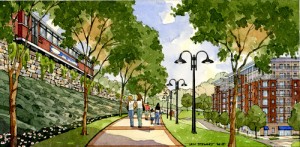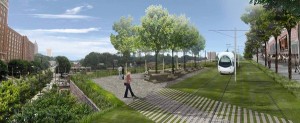Share This
Related Posts
Tags
Atlanta’s BeltLine
By Erica Rascón on Apr 16, 2013 in News
In the quest for a healthier, more transit-friendly Atlanta, a growing grassroots movement is backing the BeltLine plan.
The Atlanta BeltLine, which includes 1,300 acres of parks, 33 miles of multi-use trails, 22 miles of rail transit, and 5,600 units of affordable housing, has grown from a seedling in the mind of a Georgia Tech student into a full-fledged redevelopment movement supported by civil leaders, residents, and national environmental organizations.
Repurposed historic railway corridors and remediated brownfield make up the backbone of the BeltLine, accompanied by the addition of new parks and trails that unite various parts of the city into one, easily accessible whole.
The BeltLine has caught the attention of multiple media outlets, and recently earned praise from The Sierra Club’s Smart Choices, Less Traffic report, where it was heralded as one of the nation’s finest examples of eco-conscious transportation initiatives.
“If they pull it off, and I think they will, it will be a model, and pull them out of the economic doldrums they are in,” said Chris Leinberger, a leading scholar and expert on walkable urbanism. “The BeltLine is going to save the city of Atlanta and become a major economic generator for the entire region.”
Most civic support has been poured into the transit lines. The BeltLine holds the ability to make the neighborhoods of Atlanta more accessible and united. A poorly developed public transit system and mind-numbing traffic (Atlanta tops Forbes’ “Worst Cities for Commuters List”) currently locks residents within their neighborhoods and suburbs.
To ease transportation woes, the BeltLine will connect 45 neighborhoods via rapid rail transit, merging with existing MARTA systems to extend access to the city’s suburbs. As each segment of the BeltLine reaches completion, more residents can enjoy abbreviated commute times. Improved public transit will also reduce Georgian’s dependency on personal motorized vehicles and the carbon footprint that they leave behind.
While the transit line holds the greatest appeal for most Atlantans, it is also the source of the most contention. BeltLine progress has been vastly determined by referendums, the most recent of which failed to gain sufficient support. TSPLOST, which would have added a 1 percent sales tax to raise funds for portions of the project, was declined. Impeded but not deterred, leadership plows forward with the plan. Small victories, such as the recent Old Fourth Ward land acquisition, have kept the BeltLine vision alive.
Earlier this year, Atlanta BeltLine Inc. purchased .76 acres of land from The Trust for Public Land. Though insubstantial in size, the space will make a huge impact on the BeltLine’s cohesion. The property will connect the new Eastside Trail with Historic Fourth Ward Park, allowing pedestrians a clear connection to Piedmont Park, Freedom Park Trail, and Jimmy Carter Presidential Library complex. Construction is slated for completion in 2014. Overtime, the Historic Old Fourth Ward property will connect with six existing parks.
Researchers have realized that no single type of green space completes a snapshot of a healthier Atlanta, which is a secondary BeltLine goal. Walkability requires a combination of parks, urban gardens, playgrounds, woodlands, alternative transit routes and community plazas to develop an urban culture that is environmentally responsible and promotes residents’ physical and mental health.
This spring, Atlanta BeltLine is collaborating with the City of Atlanta to replace the Edgewood Avenue bridge. Pedestrian walkways will be added to the new structure. By April 2014, the new Edgewood Avenue bridge will connect the Eastside Trail to Lake Avenue, DeKalb Avenue, and Irwin Street. This small link in the chain proves to be as important as any other, improving pedestrian access to multiple neighborhoods and their resources.
To connect the various parks and residential corridors, a 33-mile network of multi-use trails is in the works. Fortunately for project planners, 22 miles of the trails were previously used for the railroad, thus offering relatively clear and maintained grounds upon which to build. Other portions of the trail and park system will replace dilapidated factories and storefronts. Grounds are cleared of industrial contaminants and waste before being transformed into useful spaces for recreation, exercise, and community gatherings.
While the parks, paths, and trails are welcomed improvements for most residents, the addition of affordable housing ensures that Atlantans of multiple income brackets can enjoy the health and environmental benefits of the city’s green makeover. Organizers aims to construct nearly 6,000 units of affordable housing along the Beltline. An estimated 15 percent of the net bonds will be routed to an affordable housing trust fund; those resources will be used in down payment assistance programs or to aid those renovating affordable properties in the BeltLine’s vicinity. Funds may also be used as part of an incentive program, encouraging design and build firms to focus their efforts in the area.
By beautifying existing neighborhoods and adding inclusive housing, the BeltLine enhances the value of city living while minimizing the continued deterioration of older and at-risk neighborhoods. Only 120 affordable housing units have reached completion to date, including 75 affordable owner-occupied units and 40 affordable rental units.
The scope of the project has proven to be its strength and weakness. Varied approaches are needed to improve Atlanta’s livability and reputation. Unfortunately, the plan’s vastness has been a source of confusion. To improve community understanding of the BeltLine’s goals, phases, benefits, and challenges the marketing team launched BeltLine 101, a series of information sessions that are available to the public free of charge. Residents interested in a more hands-on approach to learning are welcomed to attend BeltLine Tours which run several times a month and can be customized to accommodate community groups. For an informal approach, residents are encouraged to attend pop-up events such as the Atlanta Beltline Run Club. Representatives are often on hand at gallery showings and community events to answer questions and share updates on the plan’s progress.


